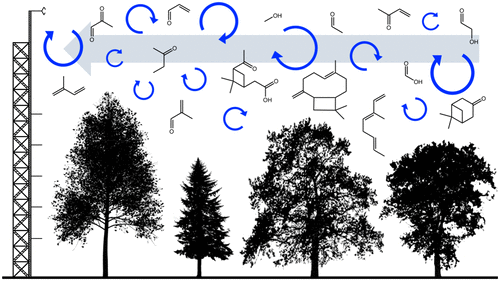当前位置:
X-MOL 学术
›
ACS Earth Space Chem.
›
论文详情
Our official English website, www.x-mol.net, welcomes your feedback! (Note: you will need to create a separate account there.)
Bidirectional Ecosystem–Atmosphere Fluxes of Volatile Organic Compounds Across the Mass Spectrum: How Many Matter?
ACS Earth and Space Chemistry ( IF 3.4 ) Pub Date : 2018-06-14 00:00:00 , DOI: 10.1021/acsearthspacechem.8b00061 Dylan B. Millet 1 , Hariprasad D. Alwe 1 , Xin Chen 1 , Malte Julian Deventer 1 , Timothy J. Griffis 1 , Rupert Holzinger 2 , Steven B. Bertman 3 , Pamela S. Rickly 4 , Philip S. Stevens 4 , Thierry Léonardis 5 , Nadine Locoge 5 , Sébastien Dusanter 5 , Geoffrey S. Tyndall 6 , Sergio L. Alvarez 7 , Matthew H. Erickson 7 , James H. Flynn 7
ACS Earth and Space Chemistry ( IF 3.4 ) Pub Date : 2018-06-14 00:00:00 , DOI: 10.1021/acsearthspacechem.8b00061 Dylan B. Millet 1 , Hariprasad D. Alwe 1 , Xin Chen 1 , Malte Julian Deventer 1 , Timothy J. Griffis 1 , Rupert Holzinger 2 , Steven B. Bertman 3 , Pamela S. Rickly 4 , Philip S. Stevens 4 , Thierry Léonardis 5 , Nadine Locoge 5 , Sébastien Dusanter 5 , Geoffrey S. Tyndall 6 , Sergio L. Alvarez 7 , Matthew H. Erickson 7 , James H. Flynn 7
Affiliation

|
Terrestrial ecosystems are simultaneously the largest source and a major sink of volatile organic compounds (VOCs) to the global atmosphere, and these two-way fluxes are an important source of uncertainty in current models. Here, we apply high-resolution mass spectrometry (proton transfer reaction-quadrupole interface time-of-flight; PTR-QiTOF) to measure ecosystem–atmosphere VOC fluxes across the entire detected mass range (m/z 0–335) over a mixed temperate forest and use the results to test how well a state-of-science chemical transport model (GEOS-Chem CTM) is able to represent the observed reactive carbon exchange. We show that ambient humidity fluctuations can give rise to spurious VOC fluxes with PTR-based techniques and present a method to screen for such effects. After doing so, 377 of the 636 detected ions exhibited detectable gross fluxes during the study, implying a large number of species with active ecosystem–atmosphere exchange. We introduce the reactivity flux as a measure of how Earth–atmosphere fluxes influence ambient OH reactivity and show that the upward total VOC (∑VOC) carbon and reactivity fluxes are carried by a far smaller number of species than the downward fluxes. The model underpredicts the ∑VOC carbon and reactivity fluxes by 40–60% on average. However, the observed net fluxes are dominated (90% on a carbon basis, 95% on a reactivity basis) by known VOCs explicitly included in the CTM. As a result, the largest CTM uncertainties in simulating VOC carbon and reactivity exchange for this environment are associated with known rather than unrepresented species. This conclusion pertains to the set of species detectable by PTR-TOF techniques, which likely represents the majority in terms of carbon mass and OH reactivity, but not necessarily in terms of aerosol formation potential. In the case of oxygenated VOCs, the model severely underpredicts the gross fluxes and the net exchange. Here, unrepresented VOCs play a larger role, accounting for ∼30% of the carbon flux and ∼50% of the reactivity flux. The resulting CTM biases, however, are still smaller than those that arise from uncertainties for known and represented compounds.
中文翻译:

整个质谱图上的双向生态系统–挥发性有机化合物的大气通量:有多少种物质?
陆地生态系统同时是全球大气中挥发性有机化合物(VOC)的最大来源和主要汇源,而这些双向通量是当前模型中不确定性的重要来源。在这里,我们应用高分辨率质谱(质子转移反应-四极杆飞行时间; PTR-QiTOF)来测量整个检测质量范围内的生态系统-大气VOC通量(m / z(0-335)在一个温带混交林上,并使用结果测试科学状态的化学迁移模型(GEOS-Chem CTM)能够很好地表示所观察到的反应性碳交换。我们表明,基于PTR的技术,环境湿度波动会导致杂散的VOC通量,并提出了一种筛选此类影响的方法。之后,在研究过程中,发现的636个离子中有377个显示出可检测到的总通量,这意味着大量物种之间具有活跃的生态系统-大气交换。我们引入反应性通量作为衡量地球大气通量如何影响环境OH反应性的指标,并表明向上的总VOC(∑VOC)碳和反应性通量所携带的物种数量远小于向下的通量。该模型将∑VOC碳和反应性通量平均低估了40-60%。但是,观察到的净通量受CTM中明确包含的已知VOC的支配(碳含量为90%,反应性含量为95%)。结果,在此环境下模拟VOC碳和反应性交换时最大的CTM不确定性与已知而不是无代表性的物种相关。该结论与可通过PTR-TOF技术检测到的一组物种有关,在碳质量和OH反应性方面,这可能代表了大多数,但在浮质形成潜力方面,却未必一定。对于含氧挥发性有机化合物,该模型严重低估了总通量和净交换量。在这里,未代表的VOC发挥了更大的作用,约占碳通量的30%和反应性通量的约50%。
更新日期:2018-06-14
中文翻译:

整个质谱图上的双向生态系统–挥发性有机化合物的大气通量:有多少种物质?
陆地生态系统同时是全球大气中挥发性有机化合物(VOC)的最大来源和主要汇源,而这些双向通量是当前模型中不确定性的重要来源。在这里,我们应用高分辨率质谱(质子转移反应-四极杆飞行时间; PTR-QiTOF)来测量整个检测质量范围内的生态系统-大气VOC通量(m / z(0-335)在一个温带混交林上,并使用结果测试科学状态的化学迁移模型(GEOS-Chem CTM)能够很好地表示所观察到的反应性碳交换。我们表明,基于PTR的技术,环境湿度波动会导致杂散的VOC通量,并提出了一种筛选此类影响的方法。之后,在研究过程中,发现的636个离子中有377个显示出可检测到的总通量,这意味着大量物种之间具有活跃的生态系统-大气交换。我们引入反应性通量作为衡量地球大气通量如何影响环境OH反应性的指标,并表明向上的总VOC(∑VOC)碳和反应性通量所携带的物种数量远小于向下的通量。该模型将∑VOC碳和反应性通量平均低估了40-60%。但是,观察到的净通量受CTM中明确包含的已知VOC的支配(碳含量为90%,反应性含量为95%)。结果,在此环境下模拟VOC碳和反应性交换时最大的CTM不确定性与已知而不是无代表性的物种相关。该结论与可通过PTR-TOF技术检测到的一组物种有关,在碳质量和OH反应性方面,这可能代表了大多数,但在浮质形成潜力方面,却未必一定。对于含氧挥发性有机化合物,该模型严重低估了总通量和净交换量。在这里,未代表的VOC发挥了更大的作用,约占碳通量的30%和反应性通量的约50%。


























 京公网安备 11010802027423号
京公网安备 11010802027423号